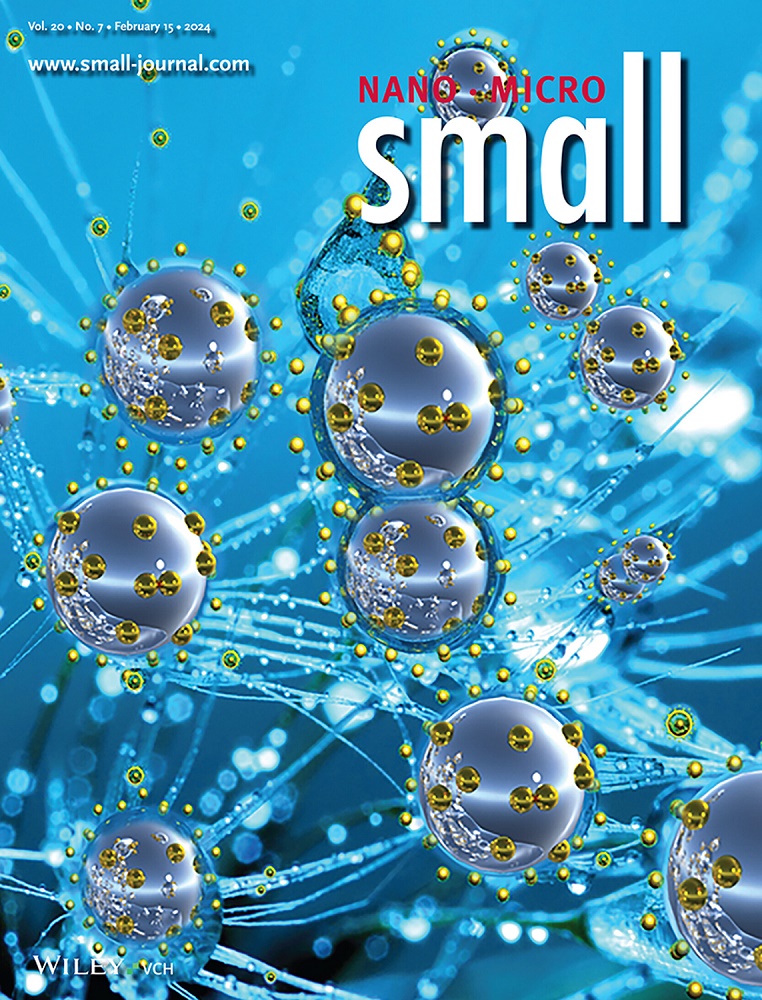Reversible Thermochromic Phase Change Material Microcapsules With High Latent Heat via Cellulose Nanocrystal Stabilized Pickering Emulsion for Smart Coatings.
IF 13
2区 材料科学
Q1 CHEMISTRY, MULTIDISCIPLINARY
引用次数: 0
Abstract
Thermochromic (TC) smart coatings are promising for temperature indicator and anti-counterfeiting. However, it is still a big challenge to fabricate multifunctional TC coatings with sustainable materials by facile approaches. Herein, reversible TC phase change material (PCM) microcapsules with high latent heat, stability, rapid color-response, and tunable color-changing temperature are facile prepared via cellulose nanocrystal (CNC) stabilized Pickering emulsion. The mixture of crystal violet lactone (CVL), bisphenol A (BPA) and PCM is used as the three-component TC material and oil phase of Pickering emulsion. Methyl behenate (MB) and coconut oil (CO) are selected as PCMs due to their excellent solubility for CVL/BPA, Pickering emulsifying ability by CNCs, and appropriate phase change temperature (PCT). The obtained TC-PCM microcapsules showed outstanding anti-leaking stability, significant thermal energy storage and release capacity (200.2 J/g and PCM content of 89.0% for TC-MB), and fast color change in seconds. The color-changing mechanism is analyzed by density functional theory. The TC-PCM microcapsules displayed blue color below PCT and turned to white above PCT, which are about 55 and 15 °C during heating for MB and CO. The applications of TC-PCM microcapsules as smart temperature-responsive color-changing coatings are also demonstrated for decorative coating, temperature indicating, information encryption, and anti-counterfeiting.利用纤维素纳米晶稳定酸洗乳液制备高潜热可逆热致变色材料微胶囊。
热致变色智能涂料在温度指示和防伪方面具有广阔的应用前景。然而,用可持续材料制造多功能TC涂层仍然是一个很大的挑战。本文采用纤维素纳米晶(CNC)稳定的皮克林乳液制备了具有高潜热、稳定性、快速变色、变色温度可调的可逆TC相变材料(PCM)微胶囊。采用结晶紫内酯(CVL)、双酚A (BPA)和PCM的混合物作为皮克林乳液的三组分TC材料和油相。考虑到甲基酚酸酯(MB)和椰子油(CO)对CVL/BPA的良好溶解度、CNCs的Pickering乳化能力和适宜的相变温度(PCT),我们选择它们作为PCMs。所制得的TC-PCM微胶囊具有良好的防泄漏稳定性,具有显著的储热和释热能力(200.2 J/g, TC-MB的PCM含量为89.0%),且在秒内变色快。用密度泛函理论分析了变色机理。TC-PCM微胶囊在温度分别为55°C和15°C时,在PCT下呈现蓝色,在PCT上呈现白色。TC-PCM微胶囊作为智能温度响应变色涂层在装饰涂层、温度指示、信息加密和防伪等方面的应用也得到了验证。
本文章由计算机程序翻译,如有差异,请以英文原文为准。
求助全文
约1分钟内获得全文
求助全文
来源期刊

Small
工程技术-材料科学:综合
CiteScore
17.70
自引率
3.80%
发文量
1830
审稿时长
2.1 months
期刊介绍:
Small serves as an exceptional platform for both experimental and theoretical studies in fundamental and applied interdisciplinary research at the nano- and microscale. The journal offers a compelling mix of peer-reviewed Research Articles, Reviews, Perspectives, and Comments.
With a remarkable 2022 Journal Impact Factor of 13.3 (Journal Citation Reports from Clarivate Analytics, 2023), Small remains among the top multidisciplinary journals, covering a wide range of topics at the interface of materials science, chemistry, physics, engineering, medicine, and biology.
Small's readership includes biochemists, biologists, biomedical scientists, chemists, engineers, information technologists, materials scientists, physicists, and theoreticians alike.
 求助内容:
求助内容: 应助结果提醒方式:
应助结果提醒方式:


